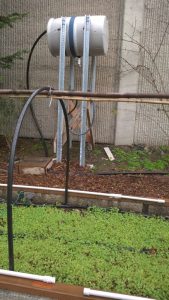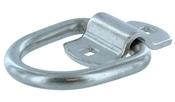Elevated Water Barrels
The gravity-fed drip irrigation suppliers suggest that the bottom of the elevated water barrel be five feet above the garden bed in order to have sufficient head pressure to deliver the water through the drip system.
We chose to mount the barrels along the sound wall due to the 400 lb. maximum weight of the barrels and to avoid blocking sun to plants. At first, we bought treated 4×4″ posts to hold the barrels. However, once we dug down and realized that the bottom of the posts would stand in water most of the year we abandoned that idea and purchased 10 foot U-Channel Galvanized posts (2lbs/ft strength type).
With no electricity at the orchard, we used a manual post driver. The beefy 2lbs/ft U-Channel post is 3 1/8″ wide so we needed a driver with an inside diameter of 3 1/2″. (Most rental shops carry 3″ drivers.) This driver weighs about 50 pounds. Driving the posts was physically the hardest thing we have ever done at the orchard. (You may want to rent a generator so you can use an electric version.) We put 5″ of concrete in the 3′ holes when we backfilled. Had we filled the entire hole with concrete we would have a much bigger job getting the posts out if we need to.
The bracing for the posts came from recycled 6′ x 6′ x 8′ lumber that a volunteer ripped into two-inch widths. The bracing is to help counteract the bowing force that the heavy water barrel can have on the four posts.
The translucent food grade water barrels are not hard to find. Our 70 gallon barrels were recycled from a nearby business that orders rice syrup by the barrel. We cleaned them out at the car wash and attached rain barrel fittings, from Kansas State University, to the bottom of barrel belly. (The Kansas “How To” video is excellent.) Our fittings included a threaded ball valve rather than the more common brass faucets valve. A ball valve allows water to flow freely without the resistance caused when using a globe valve.
We attached D-rings to the posts with 5/16″ galvanized bolts. The one recommendation that an engineer had for us was to use two nuts to the bottom bolt to add security that the D-ring would not loosen.
We opted for certified climbing webbing. We tied it to the D-rings with a bowline and ran the rope under the belly of the barrels. The climbing webbing is strong and flexible. And, to prevent the barrels from moving side to side, we added a wire to limit the horizontal movement.
Finally, we asked the volunteer who is good at math to give us the markings, from the bottom of the belly of the barrel, for this particular cylinder, from 10 to 50 gallons, by 5-gallon increments. We transferred his numbers to a piece of athletic tape and copied that for each barrel. In this manner we were able to record how many gallons we used each time we watered.

Based on an actual planting event that took place right after we filled the barrels for the first time, the following sign went up:
WOULD YOU PLANT TROMBONCINO SQUASH UNDER THIS WATER BARREL?
The barrel, with 50 gallons of water, weighs 400 lbs.
How much weight will cause the various parts of the supports to break?The 10 ft, 2 lb/foot U-Channel posts dug in 3 feet.
The 5/16″ A307 Grade A bolts holding the D-rings
2-5/16″ dia. D-ring with mounting bracket
One inch BlueWater tubular climbing webbingAnswers: 80,000 psi yield/bending strength , 60,000 psi tensile strength, 12,000 lb break strength with 4,000 lb work load limit, 4,046 Pounds force (lbf) strength




